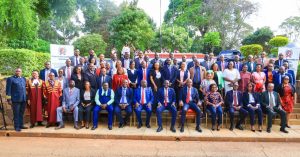By Felix Njenga
Governor Kimani Wamatangi has declared that Kiambu County is on a firm path to reclaiming its glory, outlining sweeping reforms and transformative development projects that have reshaped key sectors including education, health, infrastructure, agriculture, and water management.
Delivering the State of the County Address before the Kiambu County Assembly, Governor Wamatangi described his administration’s journey as a story of “turning hope into tangible progress,” crediting disciplined leadership, prudent resource management, and the spirit of service as the foundation of the county’s renewed transformation.
“When I took office, Kiambu’s cup was filling up. Today, that cup is almost full — and soon, it will be overflowing,” Wamatangi declared to thunderous applause from Members of the County Assembly.
Education took centre stage in the governor’s address, with Wamatangi announcing that 312 modern ECDE learning centres have been completed across the county, with an additional 178 under construction.
Each centre features furnished PP1 and PP2 classrooms, offices, play areas, and modern sanitation facilities — a far cry from the dilapidated shacks that once served as classrooms.
The governor said his administration’s school feeding programme now serves nearly 50,000 ECDE learners, providing daily fortified porridge, weekly eggs, and milk every Thursday. The results, he said, are evident: enrolment has soared from 32,000 to nearly 50,000 children in just two years.
“Our ECDE centres rival the best private academies in design and quality,” he said. “When we invest in children, we invest in Kiambu’s future.”
To complement these efforts, ECDE teachers have been absorbed into the county payroll and sponsored for higher training, while a bursary kitty expanded from KSh100 million to KSh750 million now supports thousands of learners in secondary schools and universities.
In one of the county’s most notable achievements, Kiambu has recorded zero maternal deaths at Kiambu Level 5 Hospital between January and July 2025 — a feat recognised by the United Nations General Assembly and the Federation of International Gynaecology and Obstetrics (FIGO).
The governor announced the construction of six new Level 4 hospitals in Lari, Thogoto, Bibirioni, Githunguri, Juja and Karuri, alongside 28 new Level 3 hospitals strategically placed to ensure every resident is within five kilometres of medical care.
Kiambu’s hospitals have been equipped with modern digital X-ray, ultrasound, dialysis and endoscopy machines, while 19 fully equipped ambulances — including one dedicated to maternity emergencies — have replaced costly leased services.
Over 770 health workers have been promoted, 230 new medics employed, and a Health Management Information System (HMIS) now interlinks all facilities, allowing doctors to consult remotely and monitor drug stocks in real time.
“Our healthcare revolution is not just about buildings — it’s about saving lives, restoring dignity, and creating a model for Kenya and Africa,” Wamatangi affirmed.
Addressing infrastructure, the governor unveiled the “Boresha Barabara” programme, an ambitious plan to rehabilitate at least 1,500 kilometres of roads through grading, gravelling, cabro paving, and tarmacking.
Despite missing nearly KSh1 billion from the Road Maintenance Levy Fund, the county has forged ahead, tarmacking key roads in Thika, Kamenu, Biashara, and Limuru, among others.

Wamatangi also announced the construction of bus parks in Makongeni, Kiambu, Banana, Kikuyu, Kwa Maiko and Githiga, with more planned in Juja, Kiganjo, Kamangu, and Kimende.
In a major green energy push, the “Angaza Kiambu” initiative will install 12,000 solar streetlights across the county, cutting electricity costs and promoting sustainability.
The governor praised farmers for their resilience and outlined major investments in agribusiness, including distribution of improved kienyeji chicks to 100,000 women, piglets to youth groups, and certified maize seeds and fertilizer to boost food security.
Under the Co-operatives Directorate, coffee societies such as Komothai Co-operative have been revitalised, with the price of coffee rising from KSh20 to KSh89 per kilogram. The society’s milling capacity has doubled to 1.6 million kilogrammes annually, thanks to a county-issued commercial milling licence.
Wamatangi also reported that 166,000 fish fingerlings have been supplied to farmers, alongside the establishment of a solar-powered fish market in Ruiru and a nearly completed County Aggregation and Industrial Park (CAIP) in Githunguri — a project expected to revolutionise food processing and create thousands of jobs.
The governor highlighted progress in water supply and environmental conservation, noting over 200 kilometres of new water pipelines and rehabilitated boreholes across the county.
He also announced the issuance of 10,000 title deeds under the Second Kenya Informal Settlement Improvement Project (KISIP II), giving residents long-awaited land ownership security.
Meanwhile, Kiambu has conferred municipality status on six new towns, bringing the total to twelve, and unlocked KSh1.3 billion through the Kenya Urban Support Programme.
Wamatangi said the county is now pursuing Senate approval to elevate Thika Municipality to an Industrial Smart City, positioning Kiambu as Kenya’s industrial powerhouse.
Governor Wamatangi however urged leaders and residents alike to guard the gains made and resist political distractions that could derail progress.
“We have laid a foundation of disciplined leadership, innovation, and service. The journey to make Kiambu great again is unstoppable,” he declared.
From education to health, roads to agribusiness, the message from the governor was clear: Kiambu’s transformation is not just underway — it is unfolding before the eyes of its people.



